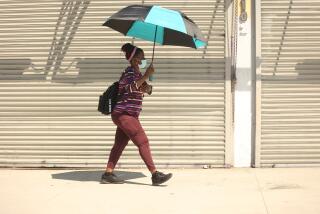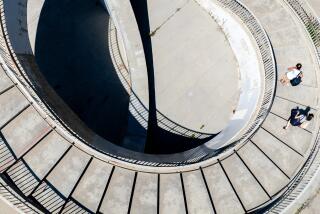KEEPING FIT : Hot, Smoggy Days Are a Challenge to Exercisers: Some Tips to Survive : There are many ways for fitness buffs to avoid fatigue and illness. Overall, it is best to remember two words--liquids and moderation.
- Share via
You’ve made the commitment to work up a sweat on a regular basis as part of a fitness regimen, and what’s more, you’re sticking to it. But what happens on those hot, smoggy days when the sweat breaks out before you’ve even finished tying your running shoes? How can you keep yourself fit without making yourself sick in the process?
Shift your workout time to 7 a.m. to take advantage of the cooler morning air? That might help, but for some it only makes things worse, says Dr. Bruce Nelson, a Capistrano Valley allergist. “There’s a lot more air pollution during the heavy commute times,” he says.
Switch from jogging to swimming for the summer? You may not get a comparable aerobic workout, says Dr. Archie Wilson, who heads the pulmonary department at UC Irvine Medical Center. “It’s a nice way to cool off, but very few people are as well-conditioned to swim at high continuous levels as they are to walk fast or run, so it’s difficult to get the same exercise benefit from swimming.”
Take salt tablets to replace the sodium lost in perspiration? Don’t, says physical therapist and exercise physiologist Mary Bailey of St. Jude Medical Center in Fullerton. “Unless you’re a marathon runner or a triathlete, that probably isn’t necessary.”
OK. How about a cold shower?
“That may sound good, but it’s really better to cool down a little slower,” says Dr. James Lindberg, medical director of the UCI Executive Health Program.
But there are healthy ways to work around hot summer weather when you’re working out, say these and other experts.
The top item on the list, both in sequence and importance, is water. An hour before you exercise, says Lindberg, prehydrate yourself by drinking a couple glasses of water. During exercise, continue to sip water, “a few swallows at a time.”
And even after your workout is over, keep sipping, says Bailey. “You should have 15 to 20 ounces during exercise, and three to six ounces afterward.”
Don’t wait until you’re thirsty, either. “In extreme conditions, thirst is no longer a good indicator of whether you need liquids,” Bailey says.
Dehydration is a common problem, the experts say. One easy way to determine how much you’re affected by it is to weigh yourself before and after exercise. “If you’ve lost more than 2% of your body weight, that’s too much,” she says.
A glass of ice water might sound like just the ticket, but the experts caution that cool water is less of a shock to the system.
You may not have much of an appetite, but don’t neglect to eat, either. “In the morning, a piece of toast without butter, maybe with a little jelly and a glass of juice,” Lindberg suggests. “You want to eat light, and emphasize carbohydrates rather than fats.”
As an alternative to plain water for hydration, Eckerling suggests Gatorade or a similar beverage. But Bailey says beverages high in sugar should be avoided.
The same things that make an aerobic workout beneficial--whether it’s jogging, brisk walking, biking or another activity--can make it dangerous in hot, smoggy weather.
“When you exercise, you breathe a lot more,” Wilson says. “The normal five to six quarts of air per minute goes up 20 times or more, depending on the level. Obviously, if there are bad things in the air, you’ll be breathing them in at least 20 times as much.
People with lung problems, Wilson says, “probably could exercise as well as they usually do. And asthma patients might actually do better. They tend to get worse if they breathe in air that is either dry or cold or both. Obviously when it’s hot and humid, that’s not a problem.”
Allergist Nelson agrees. Some asthmatics, he says, even do better exercising in the middle of the day. “It’s an individual sort of thing. Moist air, however, does cause problems because it’s more likely to contain particulate matter, which can irritate the lungs.”
If you use medicines for asthma or other respiratory problems, Nelson says, “it’s best to take them before exercise, rather than waiting until afterward when problems show up.”
And if you can, exercise near the beach, where the temperature can be 20 degrees (or more) cooler, the experts say.
Stretching, warming up and cooling down are even more important in hot weather, Lindberg says. “Before you get in the shower, give yourself a cool-down period, such as a cool-down walk, for 10 to 15 minutes to let your body temperature come down gradually.”
Those who exercise regularly react differently to heat, Bailey says. “As you get more fit, your body will perspire sooner, more, and over a greater area of your body surface. All that helps facilitate evaporation and cools you off faster.”
The first days of a heat wave can be the most dangerous, she says, because the body has not yet had time to adjust. “Research has shown that as people become more heat-acclimated, their bodies change. Someone not used to the heat will perspire with a heavy concentration of electrolyte. As you get used to the heat, your perspiration becomes more dilute.”
While you’re exercising, be on the alert for heat-related problems. “If you have chest pains, definitely stop and get help,” Lindberg says. Other symptoms to look for: dizziness, weakness, extreme fatigue. “If your skin becomes very, very dry, that’s a serious problem.”
If you experience those symptoms, try to find a cool place out of the sun, drink water and try to get some assistance, Lindberg says.
The least-serious heat injury, Bailey says, is heat cramps. Bailey says women and children are at higher risk for heat illnesses and injury than men: “Women because they don’t sweat as much, and their bodies generally have less fluid to circulate. And children have a much higher surface area per kilogram of body weight than adults. So don’t use yourself as a guide on how hot a child might be.”


